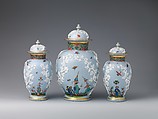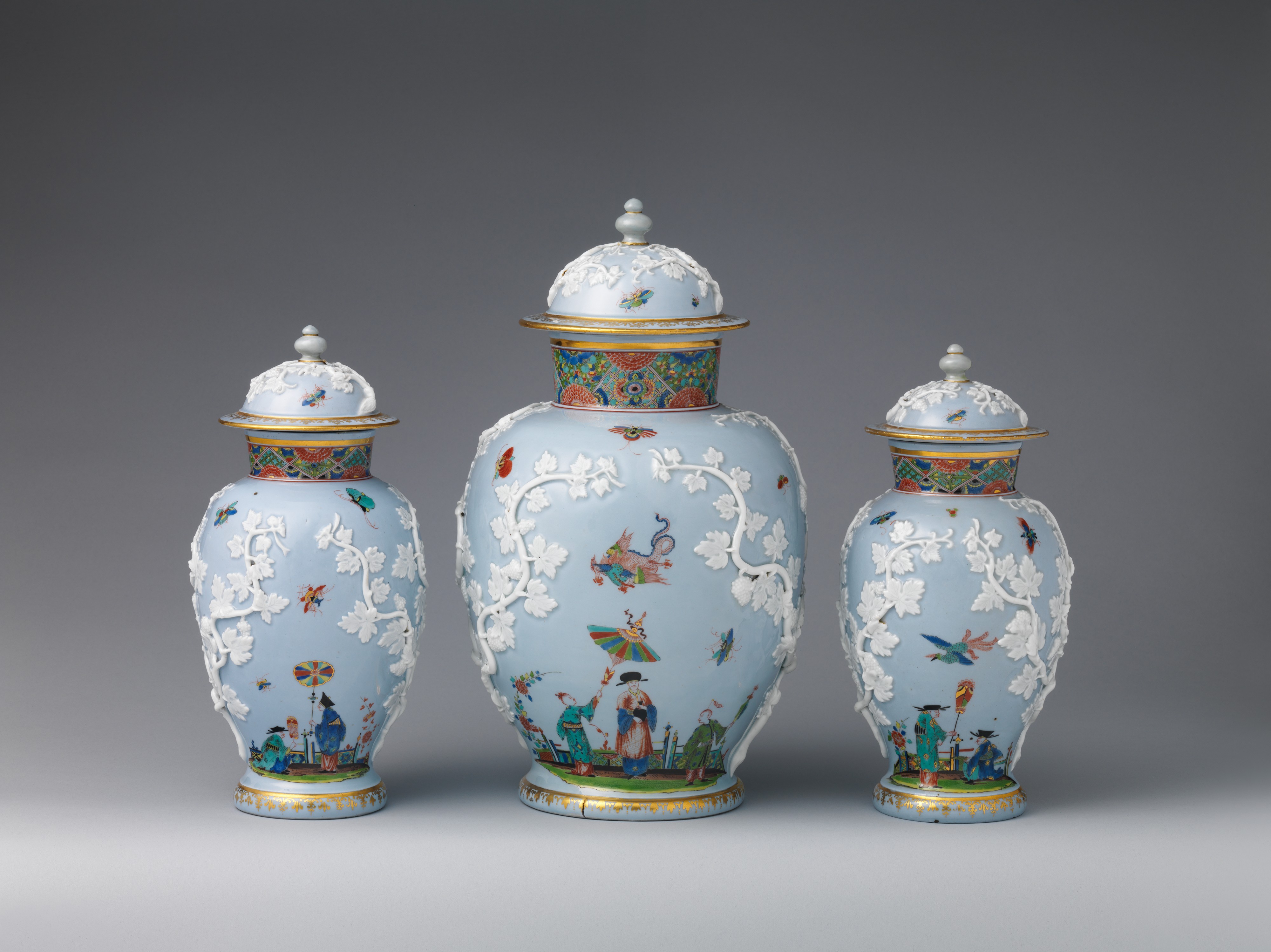Vase (from a garniture of three)
Manufactory Meissen Manufactory German
Not on view
The elaborate coat of arms and monogram of Victor Amadeus II (1666–1732), king of Sardinia, serve as the primary decoration of this beaker and saucer (54.147.75, .76), which belong to a tea and chocolate service presented as a gift by August II (1670–1733), commonly known as Augustus the Strong, elector of Saxony, king of Poland, in 1725. The porcelain service was part of a much larger diplomatic gift sent to Victor Amadeus II by the Saxon court, and due to its artistic and diplomatic significance, it has been well documented.[1] This beaker and saucer belong to one of nine tea, coffee, and chocolate services that Victor Amadeus II received, and the gift included two small services for dining, five garnitures of vases, and a variety of other pieces of Meissen porcelain, some of which were part of the Saxon royal collections but nevertheless were selected to be presented to the Sardinian king.[2] As has been noted by Maureen Cassidy-Geiger, the presentation of Meissen porcelain by Augustus to another royal court indicates the status accorded to the factory’s products by 1725, when Meissen had yet to reach its maturity.[3]
The components of this tea and chocolate service are among the earliest pieces produced at Meissen on which the armorial decoration is given such prominence.[4] Most of the saucer well is occupied by the arms of Victor Amadeus II, which are surmounted by a crown and supported on either side by lions resting on military trophies. The beaker is painted with the king’s monogram framed by palm fronds against a shield and a crown above. Both the coat of arms and the monogram are painted with a degree of detail and painterly elaboration that indicates the armorials were valued for their decorative potential in addition to their heraldic significance.
The beaker’s secondary decoration on the side opposite the monogram consists of a scene with three Chinese men and a container of lobsters. The central figure holds up a rod from which three tied lobsters are suspended, and the two figures that are seated try unsuccessfully to capture the lobsters that are escaping from the oval container. The relatively simple and straightforward composition reflects many of the qualities of the chinoiserie style introduced by the German painter Johann Gregorius Horoldt (1696–1775) around 1723, which would dominate the factory’s decoration throughout the 1720s and into the early 1730s. In the chinoiserie scenes originated by Horoldt, the figures and landscapes evoke a fantasy vision of the Far East in which all the compositional elements are imbued with an exoticism that had little to do with real life and customs yet resonated with European tastes and expectations. Horoldt’s talent lay not only in his considerable painterly skills but also in his ability to deftly create an imagined, romanticized world through gesture, silhouette, and pattern. In addition, many of Horoldt’s compositions, and those created under his influence, incorporate a sense of whimsy and humor that enhance the exotic character of the subject matter. In this instance, the escaping lobsters along with those tied on the rod with decorative bows provide the element of playfulness, which is a hallmark of many of Horoldt’s chinoiserie scenes.
While he is credited with introducing and promulgating the chinoiserie decoration that is closely identified with Meissen’s production during these decades, it is very difficult to attribute specific works to Horoldt’s hand with any certainty. In the case of the tea and coffee service with the arms of Victor Amadeus II, however, documentary evidence indicates that Horoldt himself was responsible for the decoration, making it one of the few instances in which his authorship is secure. When the service was delivered from Meissen to Dresden in March 1725, a document declares that it was “made by the court painter Herr Horoldt,”[5] and thus, the service provides a touchstone by which other chinoiserie scenes on Meissen porcelain from the mid-1720s can be assessed.
This beaker and saucer originally belonged to a service that included six tea bowls with saucers, a teapot, a sugar box, a waste bowl (for used tea leaves), and six chocolate beakers with saucers.[6] Despite the substantial number of pieces composing the service, very few are known to have survived. A beaker and saucer similar to the Museum’s examples are in the Museo Civico d’Arte Antica, Turin;[7] a sugar box is in the Bayerisches Nationalmuseum, Munich;[8] and two saucers are known, one in the Arnhold Collection, New York,[9] the other in the Palazzo Pitti, Florence.[10]
Footnotes
(For key to shortened references see bibliography in Munger, European Porcelain in the Metropolitan Museum of Art. NY: The Metropolitan Museum of Art, 2018)
1 Cassidy-Geiger 2007b, pp. 209–12.
2 Ibid., pp. 209–10.
3 Ibid., p. 211.
4 It is likely that the first tea service to be decorated with armorials shows the combined coats of arms of the Electorate of Hanover and the Electorate of the Palatine; see Meissener Porzellan 1999, vol. 2, pp. 470–71, no. 301, and a beaker and saucer in the British Museum (1931,0318.5.CR).
5 Berling 1911a, p. 174, n. 138; Berling 1911b, p. 189, n. 138; Ulrich Pietsch in Pietsch and Banz 2010, p. 190, under no. 53.
6 Cassidy-Geiger 2007a, app., p. 330. While Meissen chocolate beakers were usually made with two handles at this period, the beakers for this service were produced without them.
7 Malle 1970, vol. 2, p. 309.
8 Pietsch in Pietsch and Banz 2010, p. 190, no. 53, ill. p. 191.
9 Cassidy-Geiger 2008, p. 326, no. 98.
10 T. H. Clarke 1982, p. 25, fig. 6.
Due to rights restrictions, this image cannot be enlarged, viewed at full screen, or downloaded.
This artwork is meant to be viewed from right to left. Scroll left to view more.




